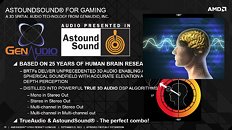Thursday, September 26th 2013

Do We Really Need AMD TrueAudio?
At its press meet called to unveil its next-generation graphics lineup, which lasted for about 3 hours and 45 minutes, a full one hour was spent detailing TrueAudio, an audio DSP that AMD co-developed with GenAudio, makers of AstoundSound technology; both of which are brand names we'd heard for the first time, and that's coming from someone who's been an audiophile and follower of PC audio technology for 15 years now. Here are a few reasons why the concept of TrueAudio, or at least the way AMD and its newfound GenAudio pals explained it, is unconvincing to the extant of flagging "snake oil." While we did not attend GPU'14, experiencing TrueAudio is irrelevant to our analysis. It focuses on what "yet another" positional audio DSP has to do with GPU, and how AMD is getting ahead of itself with non-graphics features in exactly the same way it criticized NVIDIA of doing, not too long ago.Back in the 1990s and the first half of the previous decade, discrete sound cards were an integral component of any self-respecting gaming PC, as onboard audio solutions were either too basic (ISA-based CODECs, USB-based AC'97) or sounded like greeting cards. Apart from higher fidelity, discrete sound cards offered proprietary positional-audio and DSP layers, promised hundreds of hardware-mixed audio voices, and what have you. AMD, in its presentation, didn't succeed in explaining how its solution is any different from something Dolby, Yamaha, Creative, ESS, and others haven't already tried.
With Intel's Azalia specification, and acceptable increments in audio fidelity past the 85 dBA signal-to-noise ratio mark with most motherboard-integrated audio solutions, game engine developers spent the better part of last decade innovating positional- and immersive- audio technologies that didn't require specialized hardware. You get the same incredible sound-effects on Battlefield 3 on any hardware, with discrete sound cards only offering better audio quality, but not better effects (positional- or realism). In that respect, we feel that it's quite arrogant of AMD to claim that there has been no innovation in PC game audio since programmable shaders (2001-02). To the contrary, game engine developers like Unreal, CryTek, DICE, etc., worked tirelessly to make effects comparable to three-figure discrete sound cards accessible to all gamers, by leveraging multi-core/multi-threaded CPUs.
What AMD didn't explain to us, is whether use of TrueAudio technology requires Radeon graphics cards to be installed; because if it does, then there's little difference between AMD's approach to positional-audio, and discrete sound card manufacturers', which unsuccessfully tried to make people to buy their sound cards on the "better audio immersion" plank, before switching over to the "better audio quality" plank, upon realizing that "better immersion" doesn't sell sound cards anymore.
What AMD also didn't explain is where "Radeon" fits into all this. It's a GPU alright, and combined with OpenCL, it's capable of general-purpose computing. It didn't explain whether the TrueAudio DSP layer runs on the CPU, or is something the GPU spares some of its computing power on. We're not convinced by the "hear more voices in a game" claim. The way audio is implemented on Windows, an application can stream up to 65,535 "voices" (independent streams of digital audio through a software/inter-process-communication channel), which are then mixed into "what you hear." So the only way AMD can sell "hear more voices," is if it gives developers something that can let them stream those hundreds of voices, while minimizing the CPU cost of processing and mixing them. If not having those many voices in any way steps beyond being just aesthetics (think crowds in a games like Assassins Creed, GTA), and actually affects the gameplay (i.e. not hearing all those voices puts you at a disadvantage in, say, an online multiplayer shooter), then you can bet your bottom penny that developers won't implement it.
In conclusion, even if TrueAudio made genuine improvements in the accuracy of positional audio, which they claim is backed by "25 years of brain research," there are too many factors stacked up against its successful proliferation. Want better sound? Go get a nice sound card and/or better speakers/headsets. Don't count on dinosaur DSPs anymore. There are two components to better game audio, "immersion" and "output quality." Your game developer already took care of the "immersion" part, and today's premium sound cards and speakers/headsets look after "output quality." Not much room for AMD to squeeze into this neat little arrangement.
With Intel's Azalia specification, and acceptable increments in audio fidelity past the 85 dBA signal-to-noise ratio mark with most motherboard-integrated audio solutions, game engine developers spent the better part of last decade innovating positional- and immersive- audio technologies that didn't require specialized hardware. You get the same incredible sound-effects on Battlefield 3 on any hardware, with discrete sound cards only offering better audio quality, but not better effects (positional- or realism). In that respect, we feel that it's quite arrogant of AMD to claim that there has been no innovation in PC game audio since programmable shaders (2001-02). To the contrary, game engine developers like Unreal, CryTek, DICE, etc., worked tirelessly to make effects comparable to three-figure discrete sound cards accessible to all gamers, by leveraging multi-core/multi-threaded CPUs.
What AMD didn't explain to us, is whether use of TrueAudio technology requires Radeon graphics cards to be installed; because if it does, then there's little difference between AMD's approach to positional-audio, and discrete sound card manufacturers', which unsuccessfully tried to make people to buy their sound cards on the "better audio immersion" plank, before switching over to the "better audio quality" plank, upon realizing that "better immersion" doesn't sell sound cards anymore.
What AMD also didn't explain is where "Radeon" fits into all this. It's a GPU alright, and combined with OpenCL, it's capable of general-purpose computing. It didn't explain whether the TrueAudio DSP layer runs on the CPU, or is something the GPU spares some of its computing power on. We're not convinced by the "hear more voices in a game" claim. The way audio is implemented on Windows, an application can stream up to 65,535 "voices" (independent streams of digital audio through a software/inter-process-communication channel), which are then mixed into "what you hear." So the only way AMD can sell "hear more voices," is if it gives developers something that can let them stream those hundreds of voices, while minimizing the CPU cost of processing and mixing them. If not having those many voices in any way steps beyond being just aesthetics (think crowds in a games like Assassins Creed, GTA), and actually affects the gameplay (i.e. not hearing all those voices puts you at a disadvantage in, say, an online multiplayer shooter), then you can bet your bottom penny that developers won't implement it.
In conclusion, even if TrueAudio made genuine improvements in the accuracy of positional audio, which they claim is backed by "25 years of brain research," there are too many factors stacked up against its successful proliferation. Want better sound? Go get a nice sound card and/or better speakers/headsets. Don't count on dinosaur DSPs anymore. There are two components to better game audio, "immersion" and "output quality." Your game developer already took care of the "immersion" part, and today's premium sound cards and speakers/headsets look after "output quality." Not much room for AMD to squeeze into this neat little arrangement.



87 Comments on Do We Really Need AMD TrueAudio?
so why dont give them a shoot?
thats a bit different compared to creative trowing EAX at you when you get their soundcards, and only allow EAX 5 when playing a game on their cards.
TressFX anyone? it worked on nvidia too i believe
anyhow
thats how i think it is
:peace:
Mantle is where the juice is at anyway
better sound cant hurt and wide standards will help more games sound better
When I first listened to that demo, I really had the idea that something was happening next to me in the room. Even in the best of games, stuff like that doesn't really happen, even when they're using a special audio hardware audio engine, and while using my ASUS Xonar DX card, and a 100dollar+ headphones.
So yeah, I'd say that it atleast isn't a bag of hot air. However, if they want this to really be awesome, they should let Nvidia also licence it, just like apparently the Mantle API is open and they said theres nothing keeping Nvidia from also using it.
Lets hope this is something real and something that actually makes gaming better ! :toast:
1. AMD's partners (GenAudio and AudioKinetic) are not inventing the wheel. Software based products existed for years now (and hardware, but not in regular usage in Windows). As they showed in the presentation yesterday, Convolution Reverb can eat as much as 16% of a cpu core for 5 seconds of audio, which leads me to no. 2:
2. Any hardware DSP will be far better in processing/power consumption ratio than any software based one.
3. Nvidia will follow up and probably show their implementation of hardware audio.
What is unclear to me now is that will it make all on board sound and/or discrete soundcards obsolete? (given that the speakers connect to the GPU, lets say with HDMI through a A/V receiver).
And on another thought, what if the speakers will be connected through the MB on board sound chip, will it work? will windows will know when to bypass audio?? (Will there will be a built-in WASAPI driver??? :twitch:)
Last, I watched yesterdays keynote and wasn't so excited about this tech. I fail to see how this will be even better for mobile users (and it's not launching yet) power consumption wise...
I didn't see any audio jacks on e.g. the pics of the R9 290x so it must be done like the above.
The demos online for GenAudio work from a standard stereo YouTube video and they even say it requires no special encoding (e.g. DD, DTS etc.).
It should even work over e.g. stereo radio.
Looks (and sounds) fantastic to me.
If anyone is trying the demo:
AstoundSound 3d audio demo - YouTube
Make sure to set your playback to stereo only and turn off things like CMSS-3D as they ruin it.
1. Helps developers improve gaming graphical/audio experience quicker with easier control.
2. Offers the best graphical and audio experience as intended from the developer.
3. Reduces system process loads for over all system efficiency.
4. Eliminates the need for a dedicated audio card.
5. Properly works with common audio outputs on mother boards.
EDIT: If you think further AMD is just trying to make CPU very much of a less importance - hint: Intel CPU no longer the advantage in your PC for gaming ?
Astound uses BRTF (brain),some people knew this is just plain old HRTF (head).I'm still curious about this so called True Audio,did they focused on 3D positional audio or just surround sound?From blurry slides and painful youtube buffering clearly show AMD try to make another EAX.
Like theoneandonlymrk said,Mantle playing a role here,and True Audio is "instruction set" reside within.It's not like FMOD,EAX or Miles,which is all independet API or library hogging your system resources communicate with DirectX.AMD mentioned about low-level access capability,thus enabling this to bypass DirectX...sort of.AMD may sound TRUE,but didn't have a soul LME 49720 HA and Nichicon Gold had :p
now give me R9 290 spec and price AMD! :mad:
This is even more impressive:
Virtual Barber Shop (Audio...use headphones, close...
So what is actually AMD's tech doing??
I think the crux here is that this engine can get its positional data directly from the graphics engine and does all the processing and filtering without any CPU overhead, and in real time on dynamic data. Soo to answer your question, that.
Ofc just like the virtual barber shop this still isn't 100% accurate since for a start it doesn't take into account everyone's individual ear shape, which also is quite important, especially for vertical positioning(hence why they don't really show you that in either the barber, or tech demo). Other stuff like skull size, shape, and thickness, hair and sinus properties also needs to be taken into account for the best experience.
However! I still think its a good thing like some others here also said, since this tech in the end should result in better sound quality for everyone, without causing a bigger load on the CPU.
You may be on the wrong website my friend.
As for AMD, I think they went this road because they had to put an audio chip on their card because of the HDMI DRM crap and from there on they started to think of doing more.
And incidentally, Microsoft also added 3D directsound stuff to Directx around the time of vista/w7, with some interesting expansion on what they had before, with more 3D voices and spatial emulation and what not, but they were very quiet about it all so it all went pretty unnoticed by most. (Except in the sense where games used it of course.)
Oh one more thing: I think it's good that the author asks the question. But as other commenters I also reserve final judgment until I know more.
I think going balls deep on this audio thing is a mistake.
Also, Jorge needs the heck banned. Dude is a perma troll that won't even respond to half the shit he says...waste of internets... :(
All his posts are negative. He is either bashing a brand, performance or a person.
He then never follows up. I vote ban stick please.